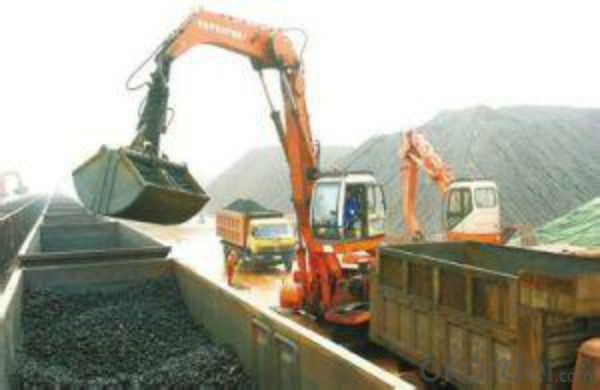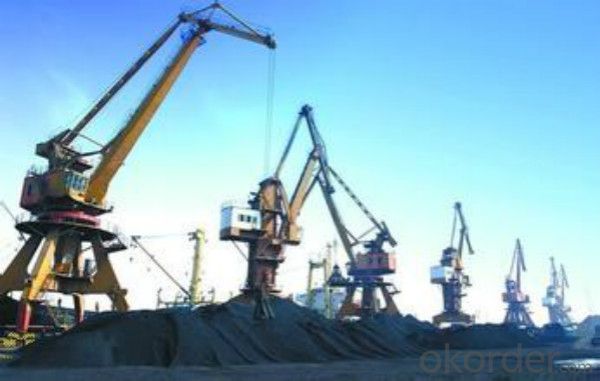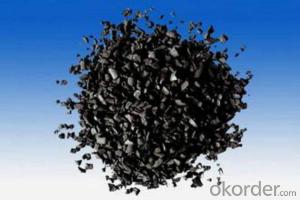Low Sulfur Coal Met Coke Manufactured in High Quality
- Loading Port:
- Tianjin
- Payment Terms:
- TT OR LC
- Min Order Qty:
- 900 m.t.
- Supply Capability:
- 15000 m.t./month
OKorder Service Pledge
OKorder Financial Service
You Might Also Like
Product Description
Met Coke(metallurgical coke) is a carbon material resulting from the manufactured purification of multifarious blends of bituminous coal. In its natural form, bituminous coal is soft;
Features
It is widely used in casting and metallurgy Smelting every tons Irons need about 0.4 to 0.6ton coke. As the reducing agent in the steel-making and foundry industry. It is playing more and more important role in the steel industry
Specification
Item No. | Ash (%) max | S (%) max | F.C. (%) min | V.M (%) max | Moisture (%) max | P (%) max | CSR (%) min | CRI (%) max | Cal.Value (≥Kcal/Kg) |
NF-M001 | 9 | 0.6 | 89.5 | 1.2 | 5 | 0.035 | 65 | 25 | 7250 |
NF-M002 | 10.5 | 0.6 | 88 | 1.2 | 5 | 0.035 | 65 | 25 | 7100 |
NF-M003 | 12 | 0.6 | 86.5 | 1.5 | 5 | 0.035 | 63 | 28 | 6900 |
NF-M004 | 13 | 0.6 | 85.5 | 1.5 | 5 | 0.035 | 60 | 30 | 6800 |
Pictures


FAQ
1 What is the packing?
Packaging Details: | 1. jumbo ton bag |
2 Delivery time? Delivery Detail: |
15 days after we get the advanced payment or original L/C |
- Q:How does carbon impact the melting of polar ice caps?
- The primary way in which carbon affects the melting of polar ice caps is through climate change. Carbon dioxide, a greenhouse gas, traps heat in the atmosphere and causes the Earth's temperature to rise. This rise in temperature leads to the melting of polar ice caps. Human activities, such as burning fossil fuels, deforestation, and industrial processes, release carbon into the atmosphere. This carbon accumulates and contributes to the greenhouse effect. As the concentration of carbon dioxide increases, more heat is trapped, resulting in global warming. The warming caused by carbon has a particularly detrimental effect on polar ice caps, especially those in the Arctic and Antarctica. Rising temperatures accelerate the melting of the ice caps, causing them to shrink and eventually collapse. This process is known as ice cap retreat. The impact of carbon on polar ice caps is two-fold. Firstly, the melting of ice caps contributes to rising sea levels, which poses a significant threat to coastal communities and low-lying areas worldwide. As the ice caps melt, the water flows into the oceans, causing them to expand. This can result in coastal erosion, increased flooding, and the loss of valuable habitats and ecosystems. Secondly, the melting of polar ice caps also disrupts the delicate balance of the Earth's climate system. The reflective surface of ice helps regulate the planet's temperature by reflecting sunlight back into space. However, as the ice melts, it is replaced by darker surfaces that absorb more heat, such as water or land. This further intensifies global warming, creating a feedback loop that accelerates the melting process. Overall, the impact of carbon on the melting of polar ice caps is significant. The continuous release of carbon into the atmosphere contributes to the loss of these crucial ecosystems, leads to sea-level rise, and disrupts the Earth's climate system. To mitigate these effects, it is crucial to reduce carbon emissions and transition to cleaner and more sustainable sources of energy.
- Q:How is carbon used in the production of graphite?
- Carbon is used in the production of graphite by undergoing a process known as graphitization, where carbon atoms are arranged in a hexagonal lattice structure. This process involves heating carbon at high temperatures, causing the carbon atoms to align and form layers, resulting in the formation of graphite.
- Q:How does carbon occur in nature?
- Various forms of carbon occur naturally in nature and it is one of the most abundant elements on Earth. It can be found in the atmosphere, the Earth's crust, and living organisms. In the atmosphere, carbon primarily exists as carbon dioxide (CO2), which is produced through natural processes like respiration, volcanic activity, and the decay of organic matter. Plants absorb this CO2 during photosynthesis to generate energy and release oxygen. Carbon is also present in other greenhouse gases like methane (CH4), which is produced by natural processes such as the decomposition of organic matter in wetlands and the digestive processes of certain animals. In the Earth's crust, carbon is present in various minerals like limestone, dolomite, and graphite. These minerals form over millions of years through the accumulation of marine organisms, such as shells and skeletons. Carbon is also a vital component of fossil fuels like coal, oil, and natural gas, which are formed from the remains of ancient plants and animals subjected to high pressure and temperature over time. Additionally, carbon is an essential element for all living organisms and serves as the foundation of organic chemistry. It is the primary component of organic matter, including carbohydrates, proteins, lipids, and nucleic acids, which are the building blocks of life. Through processes like photosynthesis, respiration, and decomposition, carbon cycles continuously within ecosystems. In conclusion, carbon occurs naturally in different forms in the environment and plays a critical role in the Earth's climate system, geological processes, and the sustenance of life.
- Q:What is the structure of carbon-based polymers?
- The structure of carbon-based polymers is characterized by a chain-like arrangement of carbon atoms, forming the backbone of the polymer. These carbon atoms are typically bonded to other atoms or groups of atoms, such as hydrogen, oxygen, nitrogen, or halogens, through covalent bonds. The properties of the polymer are determined by the arrangement and connectivity of these atoms. In addition to the carbon backbone, functional groups are often present in carbon-based polymers. These functional groups are specific combinations of atoms that can give the polymer unique chemical properties. They can be attached to different points along the carbon backbone, adding chemical diversity and altering the behavior of the polymer. The monomers, which are the repeating units in carbon-based polymers, can vary in size and complexity. For instance, simple hydrocarbons like ethylene can undergo polymerization to form polyethylene, which consists of a long chain of carbon atoms with attached hydrogen atoms. On the other hand, more complex monomers like acrylonitrile or styrene can be utilized to produce polymers like polyacrylonitrile or polystyrene, respectively. These polymers incorporate additional atoms or functional groups, resulting in distinct properties and applications. In conclusion, carbon-based polymers possess a diverse structure that can be customized to fulfill specific requirements. This versatility allows them to be utilized in a wide array of industries, including plastics, textiles, and electronics.
- Q:What are the impacts of carbon emissions on coral reefs?
- Carbon emissions have significant impacts on coral reefs. One of the most significant consequences is the process of ocean acidification, caused by the absorption of excess carbon dioxide (CO2) from the atmosphere. As the ocean becomes more acidic, coral reefs struggle to build and maintain their calcium carbonate skeletons, essential for their structure and survival. This can lead to reduced growth rates and weakened reefs, making them more susceptible to damage from storms, disease, and other stressors. Additionally, the rising ocean temperatures resulting from carbon emissions have led to widespread coral bleaching events. When corals experience prolonged exposure to high temperatures, they expel the symbiotic algae (zooxanthellae) living within their tissues, which provide them with essential nutrients and give them their vibrant colors. Without these algae, corals become pale or completely white, a phenomenon known as bleaching. If the stressors subside, corals can recover, but if the bleaching is severe or prolonged, it can lead to coral death and the subsequent degradation of the reef ecosystem. Furthermore, increased carbon emissions contribute to the intensification of storms and other extreme weather events, which pose a direct threat to coral reefs. Stronger storms can physically damage the reefs, breaking apart their fragile structures and reducing their resilience. The resulting sediment runoff from land, often exacerbated by storms, can smother corals and hinder their ability to feed and grow. The impacts of carbon emissions on coral reefs are not only detrimental to these diverse marine ecosystems but also to the millions of people who depend on them for food, income, and coastal protection. Coral reefs support a vast array of marine life, provide a source of livelihood for many communities through fishing and tourism, and act as natural barriers against storm surge and coastal erosion. The degradation of coral reefs due to carbon emissions threatens the livelihoods and well-being of these communities, as well as the overall health and biodiversity of our oceans. To mitigate these impacts, it is essential to reduce carbon emissions by transitioning to cleaner, renewable energy sources, promoting sustainable practices on land to reduce runoff and pollution, and implementing effective management and conservation measures to protect and restore coral reef ecosystems.
- Q:What are the consequences of increased carbon emissions on coastal regions?
- Increased carbon emissions have significant consequences on coastal regions. One of the most notable impacts is sea-level rise, caused by the warming of the planet and the subsequent melting of glaciers and ice sheets. This rise in sea levels can lead to coastal erosion, flooding, and the loss of coastal habitats. Additionally, carbon emissions contribute to ocean acidification, which harms marine life and coral reefs. The combination of these effects poses a threat to coastal communities, economies, and ecosystems, highlighting the urgent need for global action to reduce carbon emissions and mitigate the consequences.
- Q:What is the starting temperature and final forging temperature of carbon steel?
- The forging temperature range should be as wide as possible, to reduce forging times, improve productivity.1. initial forging temperatureInitial forging temperature is blank began forging temperature should be understood as the highest heating temperature allows steel or alloy in the heating furnace. The furnace before removing from the blank to the forging equipment to forging blank, blank size according to the delivery method and heating furnace and forging a distance between the equipment, there are a few blank tens of degrees of temperature drop. Therefore, really began forging a low temperature, the initial forging blank before, should try to reduce the temperature drop.
- Q:Who can explain that bare feet on fire carbon don't burn feet?
- First coated with Yunnan Baiyao to run, injury probability can be greatly reduced, we have such a custom inside the village, and then those children have to paint up and run, generally nothing
- Q:DNF new advanced furnace rock carbon reinforcement +10 50 powder weapons, the upper 11 probability of success is how much, how many advanced furnace rock carbon?
- Seemingly increased only 3.39 small, if we can make the cost of reaching the 80% chance of strengthening, so strengthen the probability of using advanced carbon can reach 88%. Why do you say that? First of all, let's make sure that the random ones in the game are fake. No matter what, random in the game is not real, but computer controlled pseudo random. There are two pseudo random, I simply explain. One is to simulate the real random situation, such as the weather forecast by computer simulation, in this case the random also is not true, because we had already entered the specific results, no matter how the computer is random, will have sun or rain and thunder like, the computer can not simulate the RMB under the sky the weather, because the program did not give it such a result, so although it seems very real, is actually false, is pseudo random. The other is random, which contains certain specific rules, which are widely used in competitive games, which is what we usually call the reinforcement probability. The reinforcement rate is 28%, with fixed values, but it is also controlled by the program and is pseudorandom. The reinforcement of odds is not what we imagine, but the effect of seeing Kylie's sister's feelings, whether successful or not, affects the chances of the next reinforcement. In this case, each reinforcement is not an independent event because it is affected by what happened before, and for each of the truly random or previous pseudo random events, each should be an independent event. Take random hits in the game as an example.
- Q:What is the carbon content of different fuels?
- The carbon content of various fuels can differ greatly based on their composition and source. However, fossil fuels like coal, oil, and natural gas generally contain high levels of carbon. Coal, predominantly carbon-based, typically contains approximately 60-80% carbon. This makes it a highly carbon-intensive fuel and a significant contributor to greenhouse gas emissions when burned. Crude oil and petroleum products, such as gasoline and diesel, also possess substantial carbon content, ranging from 80-90%. When these fuels are burned, they release significant amounts of carbon dioxide (CO2) into the atmosphere. In comparison, natural gas, primarily composed of methane (CH4), has a lower carbon content than coal and oil. Methane itself consists of one carbon atom and four hydrogen atoms, resulting in a carbon content of about 75%. Although natural gas emits less CO2 when burned compared to coal and oil, methane itself is a potent greenhouse gas that can contribute to climate change. Renewable fuels, like biofuels, display varying carbon contents based on their origin. Biofuels are derived from organic materials, such as plants and agricultural waste, and can have carbon contents similar to fossil fuels. However, since biofuels are obtained from recently living organisms, the carbon dioxide emitted during their combustion is considered part of the natural carbon cycle and does not contribute to long-term increases in atmospheric CO2 levels. In summary, the carbon content of different fuels plays a critical role in determining their environmental impact and contribution to climate change. The transition to low-carbon or carbon-neutral fuels is essential in reducing greenhouse gas emissions and mitigating the effects of climate change.
1. Manufacturer Overview |
|
|---|---|
| Location | |
| Year Established | |
| Annual Output Value | |
| Main Markets | |
| Company Certifications | |
2. Manufacturer Certificates |
|
|---|---|
| a) Certification Name | |
| Range | |
| Reference | |
| Validity Period | |
3. Manufacturer Capability |
|
|---|---|
| a)Trade Capacity | |
| Nearest Port | |
| Export Percentage | |
| No.of Employees in Trade Department | |
| Language Spoken: | |
| b)Factory Information | |
| Factory Size: | |
| No. of Production Lines | |
| Contract Manufacturing | |
| Product Price Range | |
Send your message to us
Low Sulfur Coal Met Coke Manufactured in High Quality
- Loading Port:
- Tianjin
- Payment Terms:
- TT OR LC
- Min Order Qty:
- 900 m.t.
- Supply Capability:
- 15000 m.t./month
OKorder Service Pledge
OKorder Financial Service
Similar products
New products
Hot products
Hot Searches




























